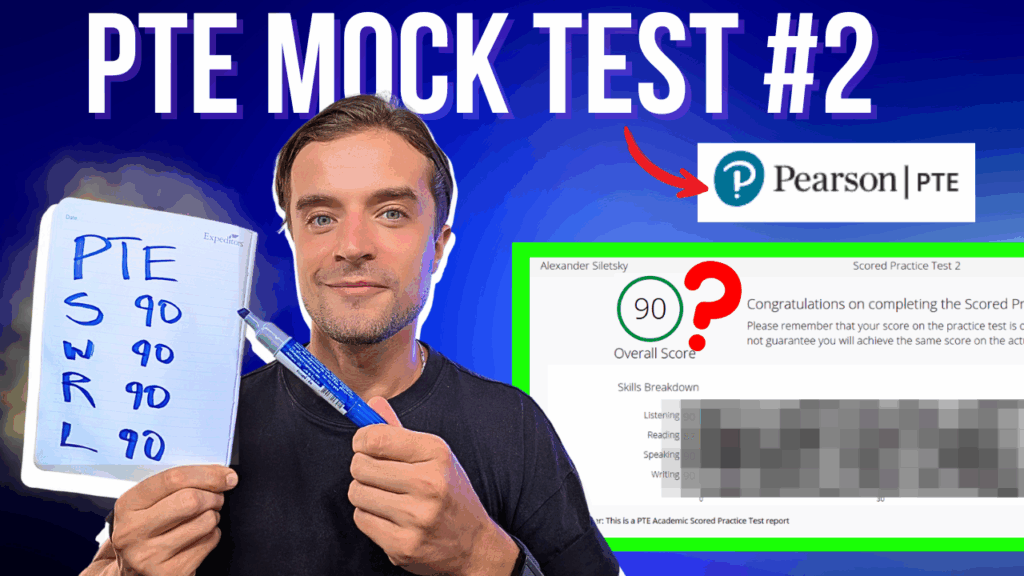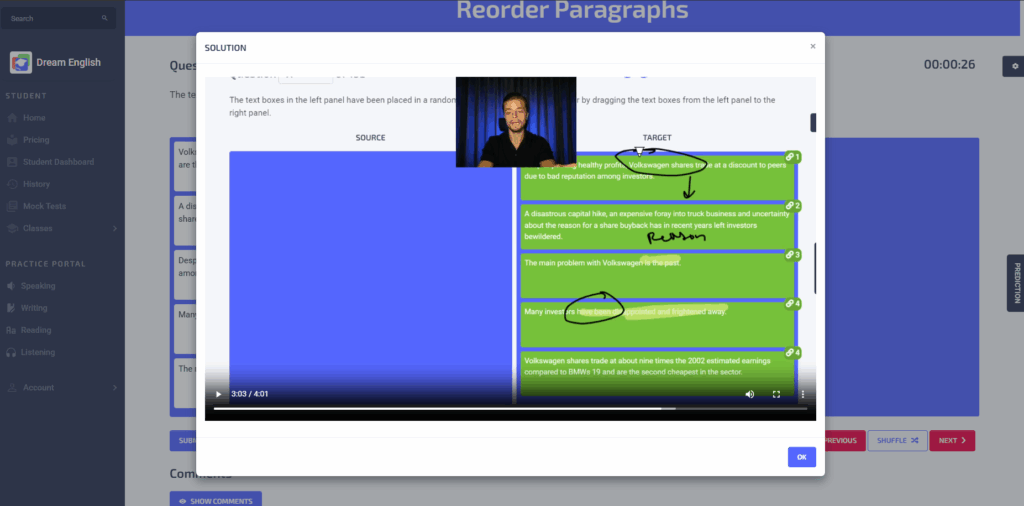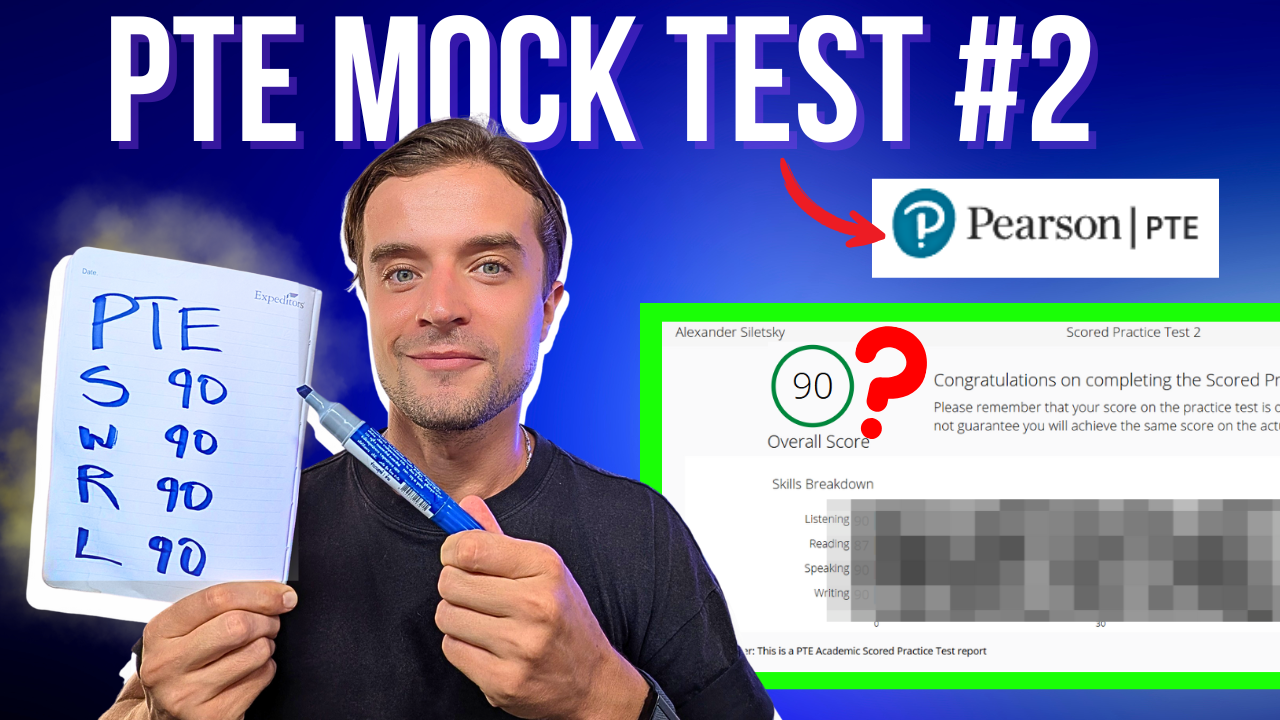How to Score 90 in PTE – 2025 NEW Strategies
How to Score 90 in PTE – 2025 Tips and Tricks
Scoring a perfect 90 in the PTE Academic test is not luck – it’s a formula. The PTE 2025 algorithm has changed, making fluency, timing, and realistic practice more important than ever. This complete guide is built from the Official Pearson PTE Mock Test (2hrs long) – which we personally find a bit expensive. Regardless, we show you how to score 90, despite the 2025 PTE exam changes that took place on August 7. If you follow these steps carefully, 90 is absolutely possible – even if you’re currently stuck around 65–75.
In this article, we’ll cover step-by-step strategies for every section of the PTE – Speaking, Writing, Reading, and Listening – and show you how to prepare smarter.
If you read till the end, you will also find a FULL 2hr PTE Tutorial video of this mock.

1. How to Score 90 in PTE Speaking (Fluency Over Perfection)
Speaking is where most students lose marks – not because of poor English, but because of hesitation, pauses, or unnatural tone. For PTE 2025, the AI places far more emphasis on rhythm, flow, and continuity than minor pronunciation errors.
Read Aloud
✅ Tip 1: Focus on flow, not perfection. Even if you make a mistake, continue without pausing or restarting.
✅ Tip 2: Practice linking words to maintain the flow, don’t stop-go-stop-go, speak smoothly!
✅ Tip 3: Maintain a consistent pace (about a 6-7 out of 10 in terms of speed)
✅ Tip 4: Don’t add or skip words. Accuracy still counts for content.
🎯 Example Practice Routine: We ask our student to doo 10 Read Alouds daily on the Dream English platform. Record, replay, and score your fluency (aim for 90+ consistently).
There are also recordings of Native English speakers, so if stuck – students can always listen to the correct way to read tough words.
Repeat Sentence
✅ Tip 1: Don’t try to remember the whole sentence. Focus on getting 5-7+ words IN SEQUENCE!
✅ Tip 2: Chunk the audio mentally (ex: remember first 2-3 words + the next 2-3 words; and then repeat those 5-6 words all together once before the recording starts)
✅ Tip 3: Speak immediately after the beep – if the recording starts and you don’t speak for 3s – you will get 0 for this question
✅ Tip 4: Don’t try to copy the speaker’s accent – it’s ok to speak in your normal way, without strong emphasis or pauses
Describe Image
✅ Tip 1: Don’t describe everything. Focus on trends or comparisons.
✅ Tip 2: Structure: Introduction → Overview → 2–3 key points → Conclusion.
✅ Tip 3: Use connectors: “The image shows…”, “It is evident that…”, “Overall…”
✅ Tip 4: Practice timing – speak for 30-35s, and click NEXT before reaching the end.
Retell Lecture
✅ Tip 1: Note down 5 keywords at a time (you don’t need full sentences!)
✅ Tip 2: Structure every response as: Introduction → 2-4 Key Points → Summary.
✅ Tip 3: Avoid filler noises like “um” or “uhh”. Keep your delivery confident.
✅ Tip 4: The ideal length is 30-35s just like in Describe Image
🎯 Dream English Pro Tip: Students who score 90 in Speaking keep one simple rule – NEVER stop mid-sentence, even if you make a mistake. Continuous speech = high fluency.
2. How to Score 90 in PTE Writing (NO OLD TEMPLATES!)
The biggest change in 2025 is AI template detection. Pearson’s algorithm can now flag repeated patterns if too many students use identical templates found online. That means your essay and summary must sound human, not robotic.
Summarize Written Text
✅ Tip 1: Combine 3-6 key ideas logically into one sentence under 75 words.
✅ Tip 2: Avoid starting with “The passage discusses…” repeatedly – vary your structure.
✅ Tip 3: Focus on cause-effect words: “because”, “therefore”, “as a result”.
✅ Tip 4: Always proofread for grammar and punctuation – try to have NO MISTAKES here!✅ Tip 5: Don’t copy the original text exactly, try to re-phrase at least 40-50% of it in your words.
Essay Writing
✅ Tip 1: Keep essays between 270–290 words.
✅ Tip 2: Use ChatGPT to generate topic-specific outlines but rewrite in your own tone.
✅ Tip 3: Ideal structure:
• Introduction (2 sentences)
• Body 1 – Argument + Example
• Body 2 – Counter-argument + Example
• Conclusion – One-sentence summary.
✅ Tip 4: Avoid overcomplicating. Simpler essays with good flow score higher.
🎯 Dream English Pro Tip: Make your own template using something like ChatGPT, so nobody in the world has the same one. You can learn more here.
It really works! See what other students had to say below:

3. How to Score 90 in PTE Reading (Logic Over Memory)
Reading remains one of the most time-sensitive sections. The key is identifying meaning fast and using logic rather than trying to memorize collocations.
Fill in the Blanks – Reading & Writing
✅ Tip 1: Look 2–3 words before and after the blank – context determines meaning.
✅ Tip 2: Don’t guess synonyms – read for logic.
✅ Tip 3: Focus on grammar clues: prepositions, verb tense, articles.
✅ Tip 4: If unsure in the moment, focus on the other (easier) blanks, and come back to the hard ones at the end of this question
Multiple Choice, Single Answer
✅ Tip 1: Read the question first, then the text.
✅ Tip 2: Eliminate extremes – answers like “always” or “never” are often wrong.
✅ Tip 3: Don’t overthink. One clear answer is always directly stated in the text.
Reorder Paragraphs
✅ Tip 1: Identify the topic sentence – it introduces the paragraph logically.
✅ Tip 2: Look for linking words: “however”, “therefore”, “in contrast”.
✅ Tip 3: Build small pairs (2 sentences that clearly connect), then order them.
✅ Tip 4: Practice daily with real exam questions! (these take time to understand)
Because many students struggle with reorders, we recorded video solutions for most them – so it’s easier for students to understand the logic:

Fill in the Blanks – Reading Only
✅ Tip 1: Look for collocations – phrases that commonly appear together.
✅ Tip 2: Always double-check spelling and grammar.
✅ Tip 3: If torn between two options, choose the one that fits grammatically and logically.
4. How to Score 90 in PTE Listening (Get Hidden Marks)
Listening also gives points in your Writing and Reading sections. Every detail counts, especially in the 1st and last tasks:
Summarize Spoken Text
✅ Tip 1: Note 5–7 keywords while listening. Focus on ideas, not full sentences.
✅ Tip 2: Write a 50–70 word summary, combining cause and effect clearly.
✅ Tip 3: Use connectors: “Additionally”, “As a result”, “Moreover”.
✅ Tip 4: Review grammar and punctuation quickly before submitting.
Multiple Choice, Multiple Answer (Listening)
✅ Tip 1: Don’t tick everything that sounds familiar. Only 2 or 3 answers are correct, but most students are better picking 1 only if not sure.
✅ Tip 2: Read the question carefully before the audio starts. Identify what it’s asking: opinion, cause, result, or recommendation.
✅ Tip 3: Eliminate options that contain extreme language (like “always”, “never”, “completely”) – the speaker rarely talks that strongly.
✅ Tip 4: Be careful with paraphrased traps. If an option uses similar words but changes the meaning, it’s wrong.
✅ Tip 5: If you’re unsure, choose fewer options – because wrong answers give negative marks.
🎯 Pro Tip: These questions test your logical listening, not your memory. Follow the speaker’s main argument and conclusion, not every detail.
Fill in the Blanks (Listening)
✅ Tip 1: Predict the missing word type before the audio – is it a noun, verb, adjective, or number?
✅ Tip 2: Type as you listen. If you miss a word, write “xx” and keep going. Never stop typing mid-audio.
✅ Tip 3: After the recording ends, use your 30–40 seconds review time to correct spelling and plural forms.
✅ Tip 4: Capitalize proper nouns and add hyphens when needed (“long-term”, “high-speed”).
✅ Tip 5: Check for grammar logic – articles (a/an/the), subject-verb agreement, and prepositions.
🎯 Pro Tip: Listening Fill in the Blanks gives points both in Listening and Writing. Try not to make more than 1 mistake per question.
Highlight Correct Summary (Listening)
✅ Tip 1: Pre-read smartly (10–12s). Skim all options and tag them mentally:
✅ Tip 2: Listen for structure. Note topic → claim → reasons → conclusion. Ignore anecdotes and side notes.
✅ Tip 3: Post-audio elimination (≤30s). Cross out options that show:
– Scope mismatch (too broad/narrow vs what you heard)
– Chronology errors (mixes up cause/result)
– Detail traps (mentions one example as if it were the main point)
– Tone mismatch (you heard balanced, option is extreme)
✅ Tip 4: If two options look similar, pick the one that best matches the conclusion you heard.
🎯 Pro Tip: 45s MAX after the audio
Multiple Choice (Single Answer) + Select Missing Word COMBINED
Weight: Low
Time rule: Max 5 seconds after the audio ends.
Mindset: It’s either obvious → pick & go, or not obvious → guess & go.
✅ Tip 1: Read the stem before audio so you know what you’re listening for (main idea / conclusion). ✅ Tip 2: During audio, track the final stance (listen for “so/therefore/overall/in conclusion”). ✅ Tip 3: After audio, scan once: if one option clearly matches the gist/ending → select it. ✅ Tip 4: If nothing is clearly right, guess immediately and move on (protect time for FIBs & Dictation). ✅ Tip 5 (Select Missing Word nuance): Pre-scan choices to label their function (conclusion / contrast / cause). If the ending sounded like a wrap-up, pick a conclusion option. If it flipped (“however”), pick a contrast option.
🎯 Pro Tip: really, don’t waste a lot of time here!
Highlight Incorrect Words
✅ Tip 1: Don’t guess! Each wrong click gives negative marking.
✅ Tip 2: Stay calm – the audio continues even if you miss one.
✅ Tip 3: Keep your eyes 1–2 words ahead of the audio to anticipate differences.
Write from Dictation
✅ Tip 1: Write immediately during the audio – don’t rely on memory.
✅ Tip 2: Every spelling mistake loses a point.
✅ Tip 3: Always add the full stop at the end.
✅ Tip 4: Review capitalization (first word must be uppercase).
✅ Tip 5: Do NOT skip or add extra words! Follow the sequence! (read THIS for more info)
5. Real Exam Strategy: How to Simulate Perfect Conditions
1. Take full-length mock tests under timed conditions.
2. Avoid distractions – wear headphones and speak naturally.
3. Review each question type immediately after the test.
4. Record your Speaking and Listening sections to identify hesitation.
5. Use AI-scored feedback to pinpoint weak areas.
Ready to Score 90 in PTE?
Thousands of students across Australia and overseas have improved their PTE scores with Dream English’s online coaching and practice platform. Join us if you need support!







